If you want to be a commercial sculptor, you’ll need to know Zbrush. That, as far as can see, is the current reality. More and more companies require it. And more and more of my colleagues are using it or are learning how to use it. Zbrush has changed the way product is created, which in turn, has changed the way it looks. But at what cost?
Traditional sculpture is very inefficient. It takes way too long, requires way too much effort and can be frustrating for an Art Director or Product Manager in that changes to a piece require the services of a hands-on sculptor. You can mouse click on a traditional sculptor all day long and nothing happens. You can mouse click a function in Zbrush and you’re done.
Just to be clear. I am old school. Any more old school and I’d be churning my own butter and waiting for Edgar Burgen and Charlie McCarthy to come on the radio. I’d be buying war bonds and reading Photoplay.
In the old days, before a piece was started, a traditional sculptor (TS) would have a conversation with their AD (art director) or PM (product manager). A conversation over the phone. In real time. Over the phone. Both the TS and the AD or PM would review the art/design for the sculpture. They’d discuss interpretation and engineering. How to make the piece factory friendly. Separate at the shoulder? Are the hands part of the arms or do they plug in. What about capes? You ask any TS what their least favorite thing to sculpt is and capes will be near the top of the list. They are a pain in the ass. Aside from trying to make the thing look as if it’s in motion (which is often what its supposed to look like it’s doing.) there’s the issue of tolerances. A cape for a cast resin piece will need to be made differently than a cape produced for PVC. There’s weight, support and factory production issues to consider.
Then, there’s reference. Before the proliferation of image hosting sites, the TS, with their AD’s help, would compile as much reference as possible. This ref would come from books, magazines or comic books. Typically, a TS would have a cork board or some such thing, covered with reference.
Sometimes, an ambitious TS would scan images to create image sheets. The down side to this method of reference accumulation was the time and effort it took. The up side of this method was the time and effort it took. The TS was forced to spend a lot of time with an array of images. And the more time they spent with them, the better they understood what they were looking at and the relevance of some of the design preferences of the artist. Every artist has a bias. A stylistic imperative. It’s up to the TS to recognize it and incorporate it if they can.
So, armed with a game plan, work can begin.
A TS starts a piece considering the practical. First step, an armature needs to be built. No two TS’s build an armature the same way. The only consistent factor is, it will need to be rock solid and contend with a fair amount of abuse. A TS will only build a weak, unstable armature once. There are few things more frustrating that laying up clay on an armature that wiggles or wobbles or worse, starts to fall apart. The key to building a good armature is for it to be solid enough to support the clay and be flexible enough to be easily repositioned.
Ok. Armature built. Now, its clay time. These days, there’s such a variety of clays available, it’s a little intimidating. In the old days, the rotary dial days, there were maybe three or four. Once a TS found their clay, They were reluctant to switch. Why? Because they’d developed and intimacy with it and switching would be akin to breaking up with a lover or abandoning a loyal pet. And am not kidding. Its not that a TS won’t switch. But it ain’t easy. Often, they’ll consider changing clays because their needs have changed. The way they work will have changed and they’ll need a material to respond to that change. A TS may find a brand they like but may use different firmnesses based on the job. A softer clay for larger pieces and a more firm clay for smaller pieces. So far, I’ve been talking about traditional oil based clays. But many TS’s use a polymer clay, like Sculpey or Fimo and will mix them for a specific density. And then there are specialty clays and water based clays. A TS working today has more choices for sculpting material than any other time in history.
Regardless of the clay a TS uses, the relationship between artist and material is unique and personal. It’s a collaboration. I’m not the first one to admit that there have been times when the clay is smarter about the job I’m working on than I am. As a TS develops a piece, they’re responding to the way light plays over the forms, how shapes relate to shapes. As a TS draws their thumb through clay, something happens. In that draw, a flow of motion is created, a character is indicated. Something so subtle can change the course of the way the piece develops. I’ve worked on pieces absolutely determined to sculpt hair a certain way. And then that unexpected shape presents itself and I’ve had to rethink the entire design. Is the clay actually smarter than I am? Probably not. Probably not. But there’s been times when a piece will want something different from what I intended and I’d have to pretty damn dim, not to pay attention to it.
And then there’s the TS’s relationship with light. Real, coming through the windows, shinning through the skylights, sunlight. Or, an array of studio lights. Either way, its real. The ability to see the piece in its natural environment is invaluable to the TS. No art is more affected by the fluctuation of light and shadow than 3D. With 2D, every element is controlled by the artist. With 3D, unless a TS comes to your house, with a flashlight and a reflector, the way their piece is lit is entirely up to the collector. Low angle light changes the look and character of a piece as does over head light or side sourced light. As the TS works a piece, they reference it under a variety of lighting conditions and those variables inform the piece.
Working with clay invites the TS to explore the vagaries of the human condition. The tilt of the head, the poise of a hand, the turn of a foot and the importance and necessity of aysetmery. And why is that? Because, often a TS will work through the action physically. The character in the sculpt is supposed to be wielding a sword. Want to know what the arms do in relation to the hips? Get up, grab a broom handle and wave it around and you’ll know. What if your character is supposed to be standing heroically. Hands on hips perhaps? Cape blowing in the wind of resoluteness? No better way to know what that looks like then to do it. Physically becoming the character helps inform it. And having the clay, right in front of you to work those issues out, grounds it in what we identify as a living gesture. As a TS, I can tell you, when you do act out your character, its best if you do it alone. It is rife with potential humiliation for a senior TS to be caught twirling around his backyard trying to get a sense of how it would look for Supergirl to experience flight for the first time.
Working a piece in clay gives the TS a greater opportunity for reflection and critical evaluation. At the end of the day, the TS will cover their piece and leave the work behind. Its not that they have stopped thinking about it. But they’re not looking at it. They come back, a gallon thermos of coffee and what could maybe pass for breakfast and see the piece with a different set of eyes under different light, at a different time of day. This reevaluation isn’t exclusive to TS’s. Every artist reflects on a piece in progress in their own way. The difference between a TS and a Digital Modeler, is that with the DM, the conditions under which they last saw the piece are exactly the same. The play of randomness is removed.
When it comes right down to it, Zbrush is a tool. Whether a sculptor uses a rake or a stylus, the quality of the art is the result of the skill and imagination of the artist who uses it. Good art is good art, it don’t get much more simple than that.
So, maybe the days of the TS working as a commercial sculptor are numbered. They probably are. Budgets are shrinking. Deadlines are being tightened. Many of the properties destined for product live as digital flies already. But there will always be place for traditional work. Maybe it will survive and thrive with smaller companies interested in exploring properties not tied to the pulse of now-media. Or, maybe traditional sculpture will find its renewed relevance in the exploration of characters alive in the pages of cloth bound books. It could happen…
In the late seventies, early eighties, acoustic music was considered on its way out. Why would you want to hire a musician to play something you could mimic on a synthesizer? Whole records were produced where the only living thing on them was the vocalist. But things settled out, as they always will. And this will too. We are too intimately tied to the human condition not to want to see it reflected back at us in our art. And somewhere that reflection will be created by a human with hands knuckle deep in clay.
Now, if you’ll excuse me, my buggy awaits…


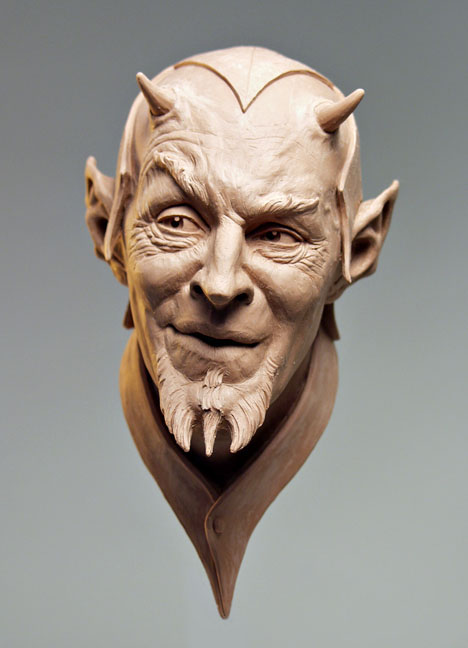



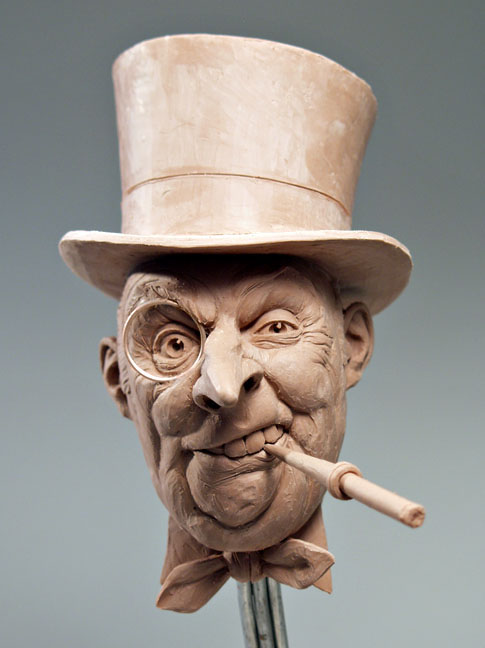


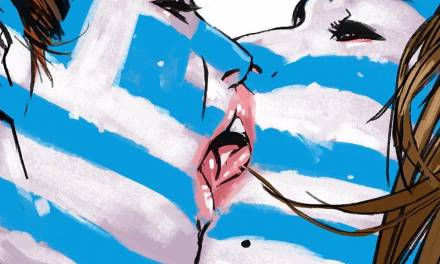
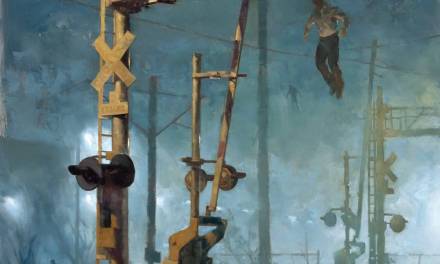
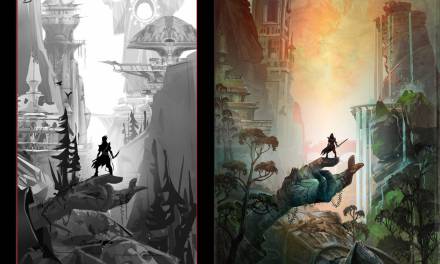
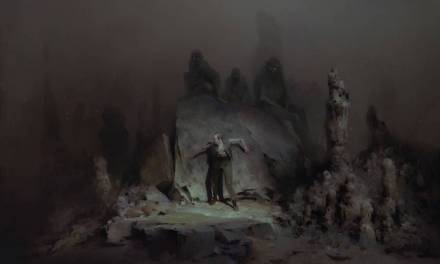
This is a great article, Tim. At one point I was pretty sure that a small sculpting studio was the career I was going to pursue for myself, focusing specifically upon miniatures for tabletop games. With the rise of digital sculpting I despaired on that. I tried out Zbrush, and while you can get great results, the process has nothing of what I enjoy about sculpting in it.
These are the things you point out – the random acts of clay, the reality of actual light, reflection, and shadow, and for me this is the kicker – the immediacy of clay and the ability to get my fingers, thumb, knuckles, and palm into the the piece, rather than just holding a stylus.
I hope that tradition sculpting has a resurgence. I have been listening to a lot of art podcasts, and it sounds like over the last few years traditional painting has been gaining ground, even amongst younger artists who were digital from the onset of their training.
I think that digital sculpting does have some pitfalls (any medium does) that I've seen come out in the finished product from time to time. With the ability to zoom in/out, and rotate freely, I think sometimes the point of view of the artist can get muddled, where if you are looking at the actual thing actual size, a certain weight of the finished product hidden within the clay sets in, and you can see that some things that may look right on a 2-d screen just do not look or feel the same in actual 3d.
Cheers for the read. I greatly enjoy your work, and I am excited to see an expanded selection of 3d art represented at SFAL this year. BTW, are you going to be doing a panel on sculpting with a digital sculptor? I thought I heard that was in the works….
Wow, fantastic article! There is a magic to traditional sculpture that cant be met with a digital sculpt, a sense of presence.
Interesting read from one of my most respected sculptors. Funny enough I started sculpting as a way to 'convalesce' from my daily stare-into-computer-screen job – apparently we've come full circle now.
I expect the cycle to occur again though, so hang on to your loop tools everyone!
TL;DR: I agree with everything you wrote.
Full story:
Funnily enough, I got into sculpting solely on the strength of your book, Pop Sculpture. Basically, I wanted to make my own figures and statues, and your book spelled out the process and warned of the pitfalls beautifully.
However, during this process I realized I'm horrible at sculpting symmetry, so I picked up Zbrush and printed stuff out through Shapeways. Everything was going well until I encountered the pitfall of all digital artists: a windstorm made a nearby transformer explode and I lost power for almost a full 24 hours.
While I sat there in the dark and later by the light of day, I remembered what an old art instructor once told our class: No medium is “better” than another; the only thing you're doing is exchanging one set of problems for another. For the benefit of digital symmetry, I tether myself to the local power grid, which is at the mercy of the elements. For the freedom from that grid, you get to frustrate yourself trying to match both eyes on a 1″ head.
In any case, your last paragraph sums up the situation perfectly: the camera didn't cause the mass extinction of painters, music synthezizers didn't cause every guitar manufacturer to go out of business, and I'm sure Zbrush (and its ilk) won't spell the end of the traditional sculptor.
The expressions on these sculptures just blow me away. Amazing.
This blog is great. I'm slowly reading every entry I find interesting. Why didn't I find this earlier? Good luck in the future, I hope you can keep up producing great articles like this <3
It was almost disclosed in some of the previous instances as to following up and giving everything well in advance. dissertation editing
nice sculptures. this is what I would like to make, but where do I start? what kind of clay do I buy and what are good pictures to copy from to make a nice transition from 2D to 3D? any guidance/sites/examples is/are welcome.